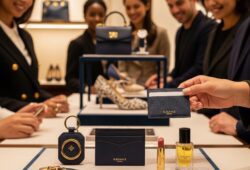Generation Z, defined as individuals born from 1997 onwards, is reshaping the beauty industry in the United States. Their distinct preferences and behaviors drive significant changes in product offerings, marketing strategies, and brand loyalty. As the largest demographic in the U.S. today, understanding Gen Z’s relationship with beauty products is essential for brands aiming to capture this influential market.
Gen Z and the Beauty Industry: Market Overview
According to Statista Consumer Market Insights, the cosmetics market is projected to experience robust growth. Revenue in the U.S. cosmetics industry is forecasted to rise from approximately $19.4 billion in 2023 to $23.6 billion by 2029, representing a 17.39% increase over the six-year period. In 2023, skincare products comprised 40% of the global cosmetics market, demonstrating a significant focus on skin health among consumers, particularly within Gen Z.
In the U.S., skincare leads the beauty market, generating $23.6 billion in revenue, followed by cosmetics at $19.4 billion and hair care at $13.2 billion. Notably, CeraVe is the most popular skincare brand among Gen Z, with 37% of respondents selecting it as their preferred choice, while e.l.f ranks as the leading cosmetics brand at 29%.
Spending Habits
Gen Z consumers are becoming increasingly willing to spend on beauty products. In 2023, according to LendingTree, 46% of Gen Z respondents indicated spending more on beauty products than the previous year. This trend is even more pronounced among millennials, with 52% stating they would cut back on other expenses to afford beauty products.
Gen Z spends about $2,048 annually on beauty products, with 27% spending between $51 and $100 per month on online beauty purchases. This trend highlights their commitment to beauty despite potential financial constraints.
Influences on Purchase Decisions
Social media heavily influences Gen Z’s beauty product purchasing decisions. In 2023, 46% of respondents admitted they spent more due to social media exposure. Notably, based on CivicScience data, 62% of Gen Z consumers reported discovering new beauty products through social media platforms, significantly more than through traditional retail channels.
The impact of influencers is profound; 42% of Gen Z consumers made beauty purchases based on influencer recommendations, reflecting the shift towards online user-generated content as a crucial factor in their decision-making process.
Brand Trust and Loyalty
Trust is paramount for Gen Z when choosing beauty brands. In 2023, Vaseline was rated as the most trusted beauty brand, scoring 47.01 on Morning Consult’s net trust index. Other brands such as Dove and Burt’s Bees also garnered significant trust, scoring 43.05 and 33.02, respectively.
Gen Z values authenticity and social responsibility, with 75% of respondents indicating they are more likely to support brands that demonstrate inclusivity and sustainability. This demographic’s inclination towards non-toxic and environmentally friendly products is shaping the product lines of many beauty companies.
Consumer Preferences
Regarding beauty product preferences, 63% of Gen Z consumers identified price as the most crucial factor influencing their purchasing decisions, closely followed by quality at 53%. The desire for variety in product offerings is also strong, with 75% of Gen Z indicating that brands should provide options for different skin tones and hair types.
The top three skincare concerns for Gen Z include acne (63%), dryness (49%), and pores (30%). This focus on specific skin issues informs the types of products brands develop and market to this generation.
Shopping Channels and Behaviors
Gen Z’s shopping habits show a marked preference for online purchasing. In 2023, nearly 50% of Gen Z consumers indicated they would prefer to shop for most of their beauty products online if given the choice. Sephora and Ulta are the leading beauty destinations for Gen Z, with 37% and 32% market shares, respectively.
Social media is the most influential channel for product discovery, surpassing traditional methods such as in-store displays or email marketing. This reflects a broader shift towards digital engagement and social media marketing within the beauty industry.
Trends in the Beauty Industry
Current trends highlight a growing interest in skincare innovations and natural ingredients. In 2023, trending skin care topics on platforms like TikTok included ectoin skincare and skin streaming, reflecting Gen Z’s focus on cutting-edge beauty solutions.
The popularity of unisex beauty products is also noteworthy. Approximately 30% of Gen Z indicate regular use of these products, underscoring a significant shift towards inclusivity in the beauty sector.
Despite their willingness to spend on beauty, Gen Z consumers are also prone to regret overspending, with over 50% admitting to remorse over significant beauty purchases. This highlights a potential opportunity for brands to promote more affordable options or value-driven offerings that resonate with Gen Z’s financial consciousness.
Moreover, as this generation prioritizes social media and influencer engagement, brands must adapt their marketing strategies to align with these preferences. Effective use of digital platforms and authentic influencer partnerships will be essential for capturing and retaining Gen Z consumers.
Generation Z is poised to redefine the beauty industry landscape in the United States. Their unique spending habits, preferences, and influences are crucial for brands aiming to succeed in this competitive market. By understanding and adapting to Gen Z’s needs, beauty brands can foster loyalty and drive growth in a rapidly evolving industry.










